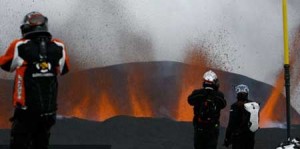 THUNDER BAY – The eruption of the Eyjafjallajokull volcano which has impacted the aviation world also has the ability to impact life in Iceland, as well as tourism. The Icelandic Tourism Board state, “The volcanic eruption in the glacier Eyjafjallajokull in South Iceland is continuing. But day-to-day life in Iceland is just as usual, even though the eruption has made a profound impact and generated dangers in a specified area. Icelandic civil protection authorities have the situation as regards public response fully under control. The affected areas have been evacuated and damage caused by flooding has been limited to roads, bridges and other infrastructure”.
THUNDER BAY – The eruption of the Eyjafjallajokull volcano which has impacted the aviation world also has the ability to impact life in Iceland, as well as tourism. The Icelandic Tourism Board state, “The volcanic eruption in the glacier Eyjafjallajokull in South Iceland is continuing. But day-to-day life in Iceland is just as usual, even though the eruption has made a profound impact and generated dangers in a specified area. Icelandic civil protection authorities have the situation as regards public response fully under control. The affected areas have been evacuated and damage caused by flooding has been limited to roads, bridges and other infrastructure”.
As of 2100 (local time) on April 17th, Icelandic Authorities state, “According to reports the eruption has remained stable. The volcanic plume reaches a height of 6-9 km drifting to the south. The volcanic fissure is about 1 km long and stretches from north to south on the southwest part of the top crater. In the seat of the volcano about 100-150 million cubic meters of the glacier have melted. This amounts to approximately 10-15% of the ice that was in the seat of the volcano. Calderas in the ice are big enough to cause the ash to build up and form craters, separating the ice from the lava flow. Ice is now melting slowly, while enough water still reaches the magma to allow explosions to continue. Floods have not occurred since last night. The weather is good in southern Iceland and the view of the volcano is good. The volcano has produced large amounts of ash and there have been reports of copious ash fall to the south of Eyjafjallajökull. For a period of time the ash fall in the area between Núpur and Skógar was serious enough to reduce visibility to less than a hundred metres. No floods have come from the glacier over the last 24 hours.
“Domestic flights have been more or less on schedule, although there have been no flights to Vestmannaeyjar islands. According to a staff member in aviation control in Vestmannaeyjar, there has been no ash fall yet (13:40). Most airports in Europe are closed, and flights are only possible in southern Europe. According to volcanic ash cloud forecasts this will not change greatly in the near future. National Route 1 has been closed on the stretch from Hvolsvöllur to Skógar. The road in Fljótshlíð has been closed east of Smáratún. There has been constant traffic of tourists in the area and cars were allowed to park in fields in Fljótshlíð where the view of the volcano is good. Landsbjörg rescue teams blocked roads in six locations today and manned a monitoring post on Þórólfsfell. Rescue teams have also travelled between farms to monitor the situation. In the area there are 160 people from 12 rescue organisations. Three scientific flights were conducted over the volcano today.
“A workgroup on psychosocial support convened in Hella this morning. According to information from the meeting there have been no special cases of health problems related to the volcanic eruption. 112 received few phone calls from the area. Health authorities held a meeting at the Civil Protection Co-ordination Centre this morning together with the representatives of health workers at the coordination centre. The meeting decided to prepare simple instructions on the use of masks in case of ash fall. It was proposed that ash fall forecasts should be broadcast with the weather forecast on television. To this end a request was delivered to the Icelandic Meteorological Office.
Representatives from the tourism industry convened today with representatives from the Ministry of Foreign Affairs and the Department of Civil Protection and Emergency Management. According to information released in this meeting around 1800 passengers are waiting for flights in Iceland. These passengers are all comfortably accommodated and the situation is calm. The waiting passengers have been offered guest passes giving them free access to museums and swimming pools. This measure is very popular among tourists.
There are no passengers waiting at Leifsstöð Icelandic International Airport.
The tiny country, which is also facing a financial crisis have moved quickly into ensuring a steady stream of information flows out to keep people informed.
Perhaps the situation in Iceland will become a case study in how to manage a crisis. From what it appears, right now the information is flowing and the Government is striving to keep it coming.
